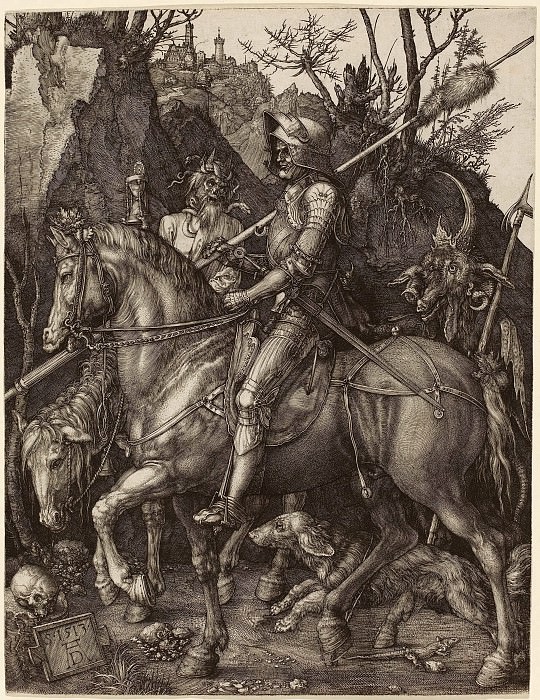Knight, Death and the Devil Durer Engravings (1471-1528)
Durer Engravings – Knight, Death and the Devil
Edit attribution
Download full size: 2322×3011 px (3,2 Mb)
Painter: Durer Engravings
"The Knight, Death and the Devil" is a medieval engraving by Dürer depicting a Christian knight riding through a narrow ravine. His horse struts proudly, carrying the rider with dignity and ease, despite the fact that the knight is chained in armor. Under the horse’s hooves a dog is running, striving to keep up, the knight himself holds a spear on his shoulder and a sword in its scabbard at his hip, he looks only ahead without turning his head, though his unpleasant, fearsome companions are walking beside him. Death, on an emaciated, pale horse, clutches an hourglass in his bony hand, reminding the knight that his earthly journey is not eternal.
Description of Albrecht Dürer’s engraving "The Knight, Death, and the Devil"
"The Knight, Death and the Devil" is a medieval engraving by Dürer depicting a Christian knight riding through a narrow ravine. His horse struts proudly, carrying the rider with dignity and ease, despite the fact that the knight is chained in armor.
Under the horse’s hooves a dog is running, striving to keep up, the knight himself holds a spear on his shoulder and a sword in its scabbard at his hip, he looks only ahead without turning his head, though his unpleasant, fearsome companions are walking beside him.
Death, on an emaciated, pale horse, clutches an hourglass in his bony hand, reminding the knight that his earthly journey is not eternal. She is braided with snakes, she has no eyes, and the fact that she triumphs last seems an injustice. The devil walks behind, a spear on his shoulder, his face wretched, piggy, stretched out - he is like a beggar at someone else’s table. But as soon as the knight stumbles, he pounces on the fallen man and starts tearing him with his sharp pig’s fangs.
And at the bottom of the gorge there are skulls, bones, a lone lizard, a dagger that had fallen out of someone’s hand. All this was left over from previous knights who had faltered, who had failed to reign in their fear and to channel it forward. Whose armor of faith had cracked under the gaze of death.
The living knight knows no fear. He is protected by the presence of God behind him. As his body is clothed in armor that won’t let another blow through, so his soul is clothed in faith that can withstand any temptation. Despite the vague sense of danger that the picture inspires - will the knight escape safely, will he be able to resist the empty eyes of death? - I can only hope for the best.
The knight moves forward very confidently, and his horse, sensing the confidence of his master, does not increase his pace in vain. He walks slowly, majestically, not showing a bit of fear. Only the dog, keenly feeling how dangerous the master’s companions are, looks frightened and runs forward, almost overtaking the horse.
Кому понравилось
Пожалуйста, подождите
На эту операцию может потребоваться несколько секунд.
Информация появится в новом окне,
если открытие новых окон не запрещено в настройках вашего браузера.
You need to login
Для работы с коллекциями – пожалуйста, войдите в аккаунт (open in new window).




















You cannot comment Why?
This engraving by Albrecht Dürer depicts a knight in full armor, astride a powerful horse, confidently riding through a dark and ominous landscape. The knights face is skeletal, embodying Death, and he is accompanied by a demonic figure to his left and a goat with devilish horns to his right. Beneath the horse, a lamb lies peacefully, seemingly unfazed by the surrounding darkness and disturbing figures, while a skull and a tombstone inscribed with 1513 and the artists monogram AD lie in the foreground.
Title: Knight, Death and the Devil
Artist: Albrecht Dürer
Year: 1513
Medium: Engraving
The engraving is rich with symbolism and can be interpreted in several ways:
The Knight: Represents a Christian warrior or a virtuous individual facing worldly temptations and the inevitability of death. His stoic expression and forward momentum suggest unwavering faith and determination in the face of adversity. The armor signifies his readiness for spiritual battle.
Death: Personified by the skeletal figure on the horse, Death is an ever-present reality. However, Dürers portrayal suggests that Death is not to be feared by the righteous.
The Devil: The demonic figure embodies evil, sin, and temptation. Its grotesque appearance and menacing gaze suggest the constant threat of spiritual corruption.
The Goat: The devilish goat is another symbol of Satan, lust, and the pagan world. Its presence further emphasizes the spiritual dangers the knight must overcome.
The Lamb: In stark contrast to the dark figures, the lamb symbolizes innocence, purity, and Christ. Its peaceful presence beneath the horse suggests divine protection and the potential for salvation even amidst turmoil.
The Landscape: The dark, rugged, and wild landscape likely represents the challenges and dangers of the temporal world, filled with temptations and trials. The distant castle might symbolize ultimate spiritual reward or the heavenly city.
The Tombstone and Date: The prominently displayed tombstone with the date 1513 and Dürers monogram serve as a signature and a reminder of mortality. It also places the work within a specific historical context, likely during a period of religious and political upheaval in Europe.
Subtexts and Interpretations:
In essence, Knight, Death and the Devil is a profound visual sermon, exploring themes of faith, virtue, temptation, and mortality, and encouraging the viewer to confront lifes spiritual challenges with courage and conviction.